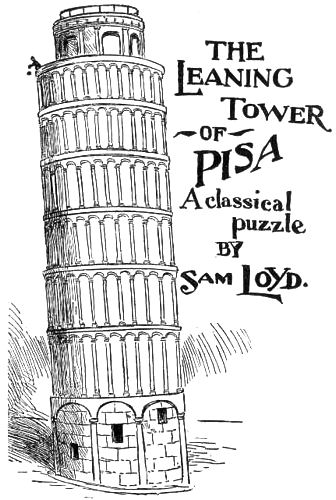



PROPOSITION—Tell how often the ball will rebound.
THE OLD DISCUSSION is being revived again regarding the accidental or intentional incline of the leaning tower of Pisa. By scientists and mathematicians the story is accepted of its having been built during the twelfth century for the scientific demonstration of certain problems pertaining to the attraction of gravitation, but others maintain that its leaning position was owing to the foundation giving way during its construction.
I note that Shepp gives a fine view of it in his photographs of the world, accompanied by the assertion that “it is fifty feet in diameter and leans thirteen feet from perpendicular. The foundation being made insufficiently solid, it began to incline before it was one-third completed. ” All of which conflicts with the information of the glib attendant who escorted us to the top, as well as being contrary to common sense. It is difficult to explain why the architect was so foolhardy as to add the other two-thirds to it’s height when the foundation was already giving way.
It is well known that Galileo’s writings tend to show that the tower was built for scientific purposes, and it was there that he refuted the philosophy of his opponents, who maintained that the velocity of a falling body was in proportion to its weight.
One of the earlier problems, however. which has been connected with the purposes for which the tower was erected, was the following the answer to which I do not find in mathematical works.
An elastic ball was dropped from the top at the tower, which is exactly 179 feet high, and on each rebound would rise exactly one-tenth of the height from which it fell. The question was to determine the distance the ball would travel before it came to rest.
Ninety-nine per cent of our puzzlists and mathematicians fell into the popular error of confounding this puzzle with the famous race between Achilles and the tortoise, and pronounce the problem to be unsolvable. Skilled mathematicians give approximate solutions and show that by the use of decimals carried out to considerable length the answers will be less than the billion billionth part of a hair.
It can be shown, however, that an elastic ball, dropped from the top of the tower, a distance of 179 feet, and which continues to rebound one-tenth of the height of each fall, will come to a rest after traveling 218 feet 9 inches and one-third.
Many make the mistake of supposing that 218.777777+ would be a more accurate answer. If the row of sevens were carried out to a billion billion decimal points it would not be so accurate as that nine and one-third inches.
If a ball dropped from the extreme top of the tower fell half of the distance in the last second, would prove the tower to be 187. 4806 feet high.
2. A REBUS.
So vast my amount, fills the mind with dismay!
Behead me, and thus take a thousand away;
Reverse what, remains, and, I'll daily dispense
To thousands, the gift of a kind Providence.
The Rebus word is Myriad.
3.
Why is an opera singer like a confectioner? Because she deals in high screams (ice creams).
A feeling all persons detest,
Altho' 'tis by every one felt,
By two letters fully express’d,
By twice two invariably spelt.
Envy (N. V.).
Why is education like a tailor? Because he forms our habits.
Why is a nobleman like a book? Because he has a title and several pages.
Why are the legs of an ill-bred fellow like an organ grinder? Because they carry a monkey about the streets.
Why is a blacksmith like a safe steed? Because one is a horse-shoer and the of her is a sure horse.
Why is a pawnbroker like a drunkard? Because he takes the pledge but cannot always keep it.
Why are photographers the most uncivil of all trades-man? Because when we make application for our photographs they begin with a negative.
Where does charity begin? At C (Sea).
Which is the strongest day in the week? Sunday, because all the rest are week-days.
When is an altered dress like a secret? When it’s let out.
[Page 154]